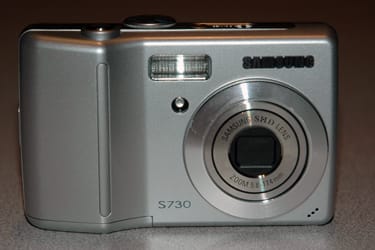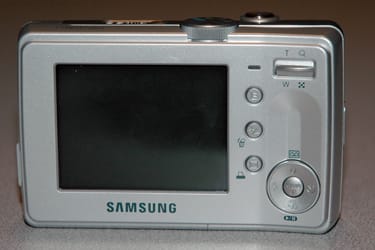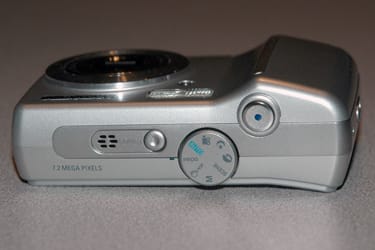Physical Tour
The biggest feature on the front of the S730 and S630 is the lens. This telescoping Samsung SHD lens has a focal length of 5.8mm to 17.4mm (that translates to a 35mm film equivalent of 35-105mm). Next to the lens is the emitter for the active auto focus and above that is the small flash. On the left is the grip, and in the bottom right, you see the holes for the microphone used to capture audio for videos or to add 10-second voice memos to photos.

Back
The major feature on the back of the camera is the 2.5-inch LCD screen with 230k pixels. This screen is clear and sharp, with plenty of detail for checking the focus on captured images. Live previews also had smooth movement and looked sharp. To the right of the screen are three buttons: The E button (the E is for effects), the exposure compensation button (which also doubles as a delete button in playback mode) and the play button (which doubles as a print button in playback mode). Next to these buttons is a 4-way directional control that doubles as a control for the voice memo, flash mode, focus mode and self timer. Finally, there is the zoom control on the top of the case, that moves up to zoom in and down to zoom out.

Left Side
The left side of the camera is home to the plastic cover that goes over the USB and power ports. This fits snugly with the side of the case. It isn’t likely to get caught in anything and torn off.

**Right Side
**The excitement on the right side of the camera body is the lanyard loop. And, that’s it.

**Top
**The top of the case is a far more exciting place to be, with the speaker grille, the power button, mode dial, and shutter. The mode dial has eight options: Auto, Program, ASR (Advanced Shake Reduction), M (for manual, not murder), Scene, Portrait mode, Night mode and Movie mode.

Bottom
The bottom of the camera has its own share of excitement. It has a slide-out cover that goes over the battery and storage card compartments. The S730 and S630 can both use either two AA disposable batteries or Ni-Mh ones, but these will cost you extra since neither camera has rechargeable batteries included.

Components
**

Viewfinder**
No viewfinder is present on the S730 or S630. All of the shooting is done using the live preview mode of the LCD screen.
LCD Screen
The 2.5-inch LCD screen has 230k pixels, and images looked clear and sharp on the pre-production device that we looked at. Images were clear enough to easily check focus, and they can be zoomed in up to 12X on playback for a close look.
Flash

The small flash unit is embedded in the front of the camera, above and to the left of the lens. We weren’t able to test the strength and quality of this unit at CES, but Samsung claims a range of 0.3 to 3 meters (0;9 feet to 9.8 feet) on the wide zoom setting and 0.4 to 2.5 meters (1.3 feet to 8.2 feet) meters at the telephoto end. That’s a pretty standard range, and our (very basic) tests at CES don’t show anything to dispute that.
Lens
The Samsung SHD lens has a focal length of 5.8mm to 17.4mm, which works out as the equivalent of 35mm to 105mm on a 35mm film camera. That’s a respectable range, but it is nothing outstanding. Photographing groups of people may be hard at the wide end of the zoom, and the telephoto end won’t let you get in that close if you’re shooting sports. But it’s a pretty standard range for this price point.

Design / Layout
Model Design / Appearance
The S730 and S630 are both available in both silver and black; we looked at the silver model. The cameras have a much less refined appearance than their more expensive siblings: gone are the glowing blue rings and buttons of the NV series. Instead, we have a relatively utilitarian, wedge-shaped design that is practical, but it doesn’t stand out from the crowd. If you were shooting with an NV7 or an L73, people might ask you about it. If you were shooting with an S730 or S630, they won’t. The case also doesn’t feel that durable. While it would be fine with small knocks and dings, I doubt it would stand up to rough treatment.
**
Size / Portability
At just under an inch thick, the S630 and S730 aren’t the thinnest cameras around. Neither are they the fattest. Though, they would easily slide into a bag or coat pocket, but it would produce an unsightly bulge in your jeans or shirt pocket. Samsung didn’t specify a weight for the cameras, and we were unable to weigh them. However, they felt like they were on the lighter side at under a pound.
Handling Ability
The wedge-shaped design of the S630 and S730 makes for comfortable handling. While the deeper body may make for bulging pockets, it also gives more for the hand to hold onto. We found that the shutter fell naturally under the index finger, and the zoom control under the thumb.
Control Button / Dial Positioning / Size
The shutter and zoom controls are well placed for one handed use as both fall naturally under the fingers. The mode dial can also be reached with the thumb, but the other controls require the other hand to brace the camera while in use. However, they are all adequately sized and it’s pretty easy to figure out what they do.
Menu
The menus are reasonably well structured with the numerous buttons providing quick access to the sub-menus, none of which are more than a few layers deep. Pressing the menu button in the middle of the directional control gives the following options:
Ease of Use
Although the S730 and S630 lack the Smart Touch control system of the more expensive L73 and NV series, they are pretty intuitive and easy to use cameras. The onscreen menus are well structured and don’t require a huge amount of button pressing to navigate. It’s not the easiest camera to use that we’ve seen, but it’s simple enough for most users.****
Modes
Auto Mode
The full auto mode takes control of most of the features of the camera away from the user and puts them under the purview of the silicon brain buried deep in the camera. The only options that the user can control are image size and sharpness.
Movie Mode
Movies are captured at a maximum resolution of 640 x 480, with an option to capture at a lower resolution of 320 x 240, both at either 30 frames per second or 15 frames per second. Movies are captured as Motion JPEG files, which tend to be larger and of lower quality than the MPEG-4 files that more expensive camcorders capture. The zoom can be used while filming, but the camera makes the slightly odd move of muting the sound while zooming. This sounds odd, but it is more attractive than the annoying buzzing noise that most cheap zoom mechanisms provide. Mono audio is captured, although this can be disabled if you prefer silent movies to those modern talkies.
Drive / Burst Mode
Samsung didn’t release any information on the number of frames per second that either camera can capture, and we were not able to do any realistic testing on the model that we looked at. Samsung was keen to point out that both the camera and the software on it were pre-production.
Playback Mode
The playback modes of the S630 and S730 are basic but adequate. Images can be played back singly, as thumbnails showing nine images on screen, or as slideshows.
Custom Image Presets
As well as the auto and program modes, the S630 and S730 include nine scene modes: Night, Portrait, Landscape, Close-up, Sunset, Dawn, Backlight, Fireworks, Beach & Snow. The first two modes are also available directly from the mode dial that is an interesting touch that makes them easier to access quickly. The portrait mode makes sense here, but the Night mode is an odd choice since we would have preferred to see this valuable dial real estate taken by the Landscape mode.
Control Options
Manual Control Options
Unusual for a budget point-and-shoot model, the S630 and S730 have a manual mode on the mode dial. Putting the mode dial to M allows the user to set the shutter speed and aperture directly. However, we weren’t able to test this on the pre-production model since the manual mode didn’t work.
Focus
Auto Focus
The auto focus is a contrast detection system that can focus down to a minimum distance of 5cm in macro mode and 80cm in normal mode. In our limited tests, we found the auto focus to be relatively quick, although it did have some problems focusing in on dark subjects in the low lighting of the meeting room at CES where we tested the pre-production unit.
Manual Focus
No manual focus mode is available on the S630 or S730.
ISO
The ISO range of the S730 goes from 80 to 1000, while the S630 only goes up to a maximum of 800. That’s a pretty wide range for a budget camera, though.
White Balance
Both cameras provide several options for white balancing; there is an auto mode and 5 presets, plus an evaluative setting that picks the white balance from a captured image.
Exposure
As well as the full manual mode, the S630 and S730 offer two stops of exposure compensation either over or under, with 1/3 of a stop steps on the way.
Metering
Only two metering modes are offered: multi metering mode which checks several spots in the image and picks the exposure based on them and Spot mode which uses the center of the image to decide how to expose the image. That’s not a wide selection (there is no center weighted, for instance), but it’s adequate for most of the users this camera is designed for.
Shutter Speed
A combination mechanical and electronic shutter gives the shutter speed a range of 1 second to 1/1500th of a second, that is more than adequate for most users. Putting the camera into the manual mode ups the slowest shutter speed to eight seconds, although we would anticipate that noise would become an issue with the longer exposures.
Aperture
The Samsung SMC lens has an aperture range of f2.8 to f7.1 at the widest zoom setting, and f4.9 to f12.4 at the telephoto end. That’s an acceptable range, but it is a little small. This isn’t a camera that’s going to have a big depth of field or the ability to blur the background by opening the aperture up.
Image Parameters
Picture Effects Mode
Pressing the E (for effects) button on the back of the camera brings up the effects menu, where you can make photos black and white, shift colors around or create other special effects such as picture frames. These are gimmicky, and I doubt that many people will actually use them. You should remember that there is no way to undo the effect once it is applied.
Connectivity / Extras
Connectivity
Software
Samsung supplies their Digimax Master software with the camera. It is a basic image editing and cataloging program. This can also scan images taken in the camera’s text mode and try to convert them to raw text.
Jacks, ports plugs
The USB and power ports are both on the camera body itself. Hence, there is no need to carry around an extra camera dock if you are taking the camera on the road. The USB port also doubles as a video output with the included video cable.
Direct Print Options
Both DPOF and PictBridge are supported, providing a way for the camera to flag images on the SD Cards it uses for image storage for later printing, and to connect directly to a PictBridge printer.
Both cameras can be powered by either two AA disposable batteries or by AA NiMh batteries. This provides a good balance. You can use the rechargeable batteries but buy a couple of the disposable ones if you run out of charge away from a charger. However, the rechargeable batteries are not included: You have to buy them separately.
Memory
16MB of memory is built into both cameras, but SD Cards or the newer, faster SDHC Cards provide the main storage option. Cards that hold up to 4GB are supported, which should provide plenty of space.
Other Features*
ASR* – Samsung make much of their ASR (Automatic Shake Reduction) feature, which boosts the ISO setting and shutter speed to minimize camera shake in dark locations. We weren’t able to test this feature on the show floor but settings like this don't produce the same results as a more fully-fledged optical or sensor-based image stabilization system. However, they do correct for subject motion in addition to hand shake.
Overall Impressions
Value
Both of these cameras are well priced at the budget end of the market. The S630 will have an MSRP of $179.99, and the S730 has an MSRP of $199.99. They’ll probably be available at street prices, some way below thMSRP. They aren’t the cheapest cameras in this class, though. The 7.1 megapixel Kodak EasyShare C743 can be bought for about $150, while the Fujifilm Finepix F700 is available for about $150 on the street. The Samsung cameras aren’t likely to be found much more expensive than these.
Who It’s For
Point-and-Shooters – These simple cameras provide simple, straightforward features that should satisfy most shooters who just want to point and click.
Budget Consumers – There are cheaper cameras available, but the S630 and S730 are competitively priced for the photographer on a budget.
Gadget Freaks – There really aren’t enough bells and whistles on these cameras to satisfy your inner gadget freak.
Manual Control Freaks – Although this camera does have a manual mode, exposure controls are not flexible enough for this demographic.
Pros / Serious Hobbyists – Pull this camera out when your pro photographer buddies are around and you’ll be laughed out of the serious shooters club.
Conclusion
**
**
****Conclusion****
The S730 and S630 are budget cameras in both price and features. Neither has any features that really excite us, but they are both competent cameras that are priced under $200, almost an impulse buy. The LCD screen is good, and the controls are straightforward. As such, they would be well worth a look for the casual shooter who doesn’t want to lay out a fortune to get photographing.
Meet the tester
Richard Baguley is a veteran writer who has written about technology ranging from Alphabet to Zip file utilities. He has contributed to pretty much every major tech publication, including Amiga Format Magazine, PC World, Wired, CNET, Toms Guide, Forbes, and many others. He lives in the Boston metro area with his wife, dog, and an indeterminate number of cats.
Checking our work.
Our team is here to help you buy the best stuff and love what you own. Our writers, editors, and experts obsess over the products we cover to make sure you're confident and satisfied. Have a different opinion about something we recommend? Email us and we'll compare notes.
Shoot us an email